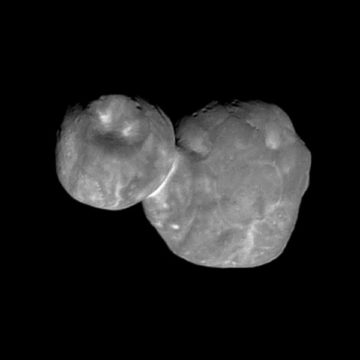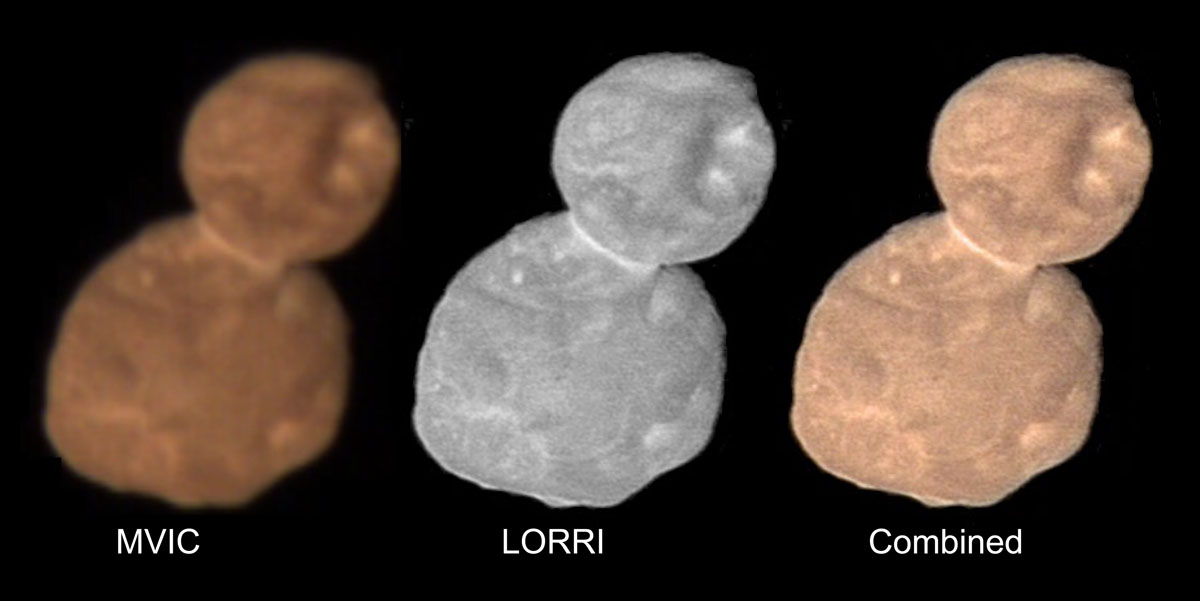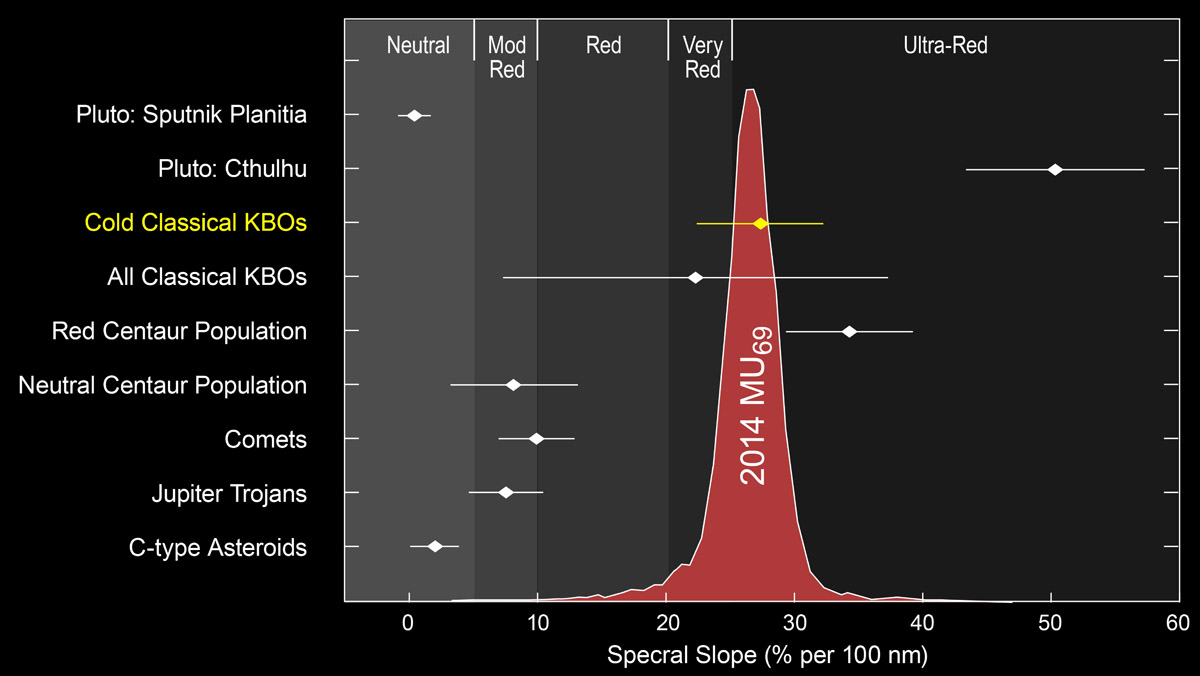As observations trickle in from NASA's New Horizons spacecraft, mission scientists have new insights on how their two-lobed target formed in the Kuiper Belt.
It's been 2½ months since NASA's piano-size New Horizons zipped past a tiny target in the Kuiper Belt in the first hours of New Year's Day. That body, formally designated (486958) 2014 MU69 and nicknamed "Ultima Thule" by mission scientists, wasn't even discovered until 8½ years after the spacecraft's launch. Since the flyby, enough observations have trickled back to Earth to start to piece together this object's remarkable story — and this week those first chapters are being presented at the annual Lunar and Planetary Science Conference.

NASA / JHU-APL / SWRI
In a sense, the 40 flyby-related presentations at LPSC represent the science team's first "victory lap" with their peers. As principal investigator Alan Stern (Southwest Research Institute) points out in his most recent blog for S&T.com, "Every planned observation, by every one of the scientific instruments aboard New Horizons, performed according to plan."
Most intriguing are the results that detail 2014 MU69's surface geology and composition — and what those reveal about this curious object's origin. This body has a dynamically "cold" orbit: Its low inclination and eccentricity suggest that nothing has perturbed its motion significantly.
So, crucially, the spacecraft had the good fortune to examine a pristine relic that formed at the outer fringe of the solar nebula 4½ billion years ago.
A Flattened Snowman
Early returns from New Horizons revealed an object 35 km (21 miles) long with two like-sized lobes that resembled a backyard snowman. But as more images reached Earth, it became clear that both lobes have a flattened shape, with the larger one (dubbed "Ultima") more so than somewhat smaller "Thule."
The two lobes have a lumpy uneven texture that investigator Kirby Runyon (also at SwRI) likens to round loaves of "monkey bread." A few small pits appear around the edges, but overall the surface isn't heavily cratered. In fact, a large depression on Thule that the team has dubbed Maryland might be the only large crater in view.
Overall both lobes are dark, 7% reflective on average with a few brighter spots here and there. (This is a close match to the reflectivity of the Moon.) The brighter spots might mark the locations of degraded impacts, but the "high-Sun" illumination makes it difficult to know if they're depressions or something else.
Much of the team's attention has focused on the narrow "neck" where the two lobes join. The evidence suggest a gentle merger — there are no "splat" deposits or stress fractures, for example — and the contact is girded by a thin "collar" that's both brighter and less red than elsewhere. So far, investigators can only guess how and when it got there.

NASA / JHU-APL / SwRI
Color Cues
More than just being dark, the surface of 2014 MU69 is strongly red. As the plot below shows, it's some of the reddest material in the outer solar system. But, as Silvia Protopapa (SwRI) notes, it's also a close match to the red hue of other "cold, classical" Kuiper Belt objects that have been observed from Earth.
The LEISA spectrometer aboard New Horizons scanned the surface repeatedly as the spacecraft swept by. The resulting spectra not only confirm the strongly red surface coloration but also reveal three distinct dips at near-infrared wavelengths. Those at 1.5 and 2.0 microns are due to water ice, Protopapa reports, and the third at 2.27 microns reveals the presence of methanol (CH3OH). This simple organic compound, often observed in outgassing comets, forms when methane (CH4) is oxidized.

NASA / JHU-APL / SwRI
All this fits nicely in an overall picture: Kuiper Belt objects should have contained ample methane and water ice when they formed, and over time space radiation and ultraviolet photons from the distant Sun would have converted these into more complex hydrocarbons, known as tholins, with distinctly dark, reddish hues. How much water and methane might lie deeper down is unknown: Since the two lobes are in contact, rather than orbiting one another, there's no way to determine their density and thus gain clues to their overall composition.
Ideally, a tiny moonlet would turn up in one of the images still stored aboard New Horizons. That discovery would quickly provide a density estimate for 2014 MU69. Stern points out that it will take until August or September of 2020 to receive all the flyby observations. Those likely will provide many more discoveries and surprises.
Seeing Double in the Kuiper Belt
Even before New Horizons made that picture-perfect flyby earlier this year, ground-based observers had used results from a challenging stellar occultation in July 2017 to deduce that 2014 MU69 was probably either a pair of like-size objects orbiting each other very closely or a "contact binary" (which it proved to be). In fact, the Kuiper Belt seems to veritably bristle with double objects — far more than theorists expect via the conventional notion of primordial bodies growing stepwise from pebbles to boulders to planetesimals.
What New Horizons found was not merely "a meatball attached to a pancake," explains William McKinnon (Washington University) but instead "something even more unique and strange." The two lobes' main axes are aligned to within 10° — clear evidence, McKinnon says, that they were lined up this way when they came together — and it wasn't by chance.
Instead, in recent years dynamicists have come to embrace a way to assemble solar-system bodies very rapidly — and often as paired objects — via a process called streaming instability. The details are a little messy, but here's the basic idea: In a rotating disk of gas and small solid particles, the stuff closer in rotates faster than the stuff farther out. Usually they slide by each other smoothly, in what's called laminar flow.
But researchers found that the particles experience gas drag in a way that causes them to clump together rather than just slide past each other. Other particles collide with these clumps, and the little clumps grow into large masses rapidly. (Here's a helpful video.) That rapid growth would have been a big advantage out in the primordial Kuiper Belt, where mass was in short supply and encounters infrequent.
Even better, all that clumping would have induced turbulence, which in turn triggered rotation within the growing clumps, which ended up creating lots and lots of binary bodies. A 2010 analysis by David Nesvorný, Andrew Youdin, and Derek Richardson showed that streaming instability offered an easy and efficient way to make the big Kuiper Belt binaries being discovered from Earth, and it probably led to lots of little binaries as well.
McKinnon cautions that no one yet knows how 2014 MU69 might have lost the angular momentum to evolve from a close-orbiting pair of objects to a contact binary. Nor is it clear why the now-joined pair rotates so slowly (in roughly 15 hours). A close look at the spacecraft's yet-to-be-transmitted observations might offer more clues.
Finally, for an amazing "you are there" experience, click below to play a composite video of New Horizons images showing 2014 MU69 as seen by New Horizons — starting from a faint blip against the star fields of Sagittarius to the resolved double-lobed visage that greeted the spacecraft during the flyby — accompanied by a soundtrack of the song "New Horizons" by Queen guitarist Brian May.
 2
2









Comments
Gene Stemple
March 29, 2019 at 12:48 pm
Could New Horizons, with its LORRI camera, get a parallax measurement for Proxima Centauri that would be more accurate than the Gaia, or Hipparcos, data by taking advantage of its ~40 AU baseline distance from the Earth? Maybe something the New Horizons team could do next year when on-board storage and downlink bandwidth are no longer needed for the MU69 data. I only mention Prox Cen as an example and other nearby stars might also be candidates. Any studies of missions to Proxima would want to know the distance as accurately as possible.
You must be logged in to post a comment.
fif52
April 3, 2019 at 8:04 pm
Could the methanol be produced when sub surface methane is oxidized during small particule collisions, vapourizing hydrogen and oxygen? Methane found sometimes in ice or in locations where ice is present, these could be sub surface deposits covered in dust or craters which are sheltered from direct sunlight where an accumulation of vapour could freeze followed by layers of dust or sand. A recent water/methane filled crater was found near Mars' polar region, whether this was from accumulation of water/methane is still unclear.
You must be logged in to post a comment.
You must be logged in to post a comment.